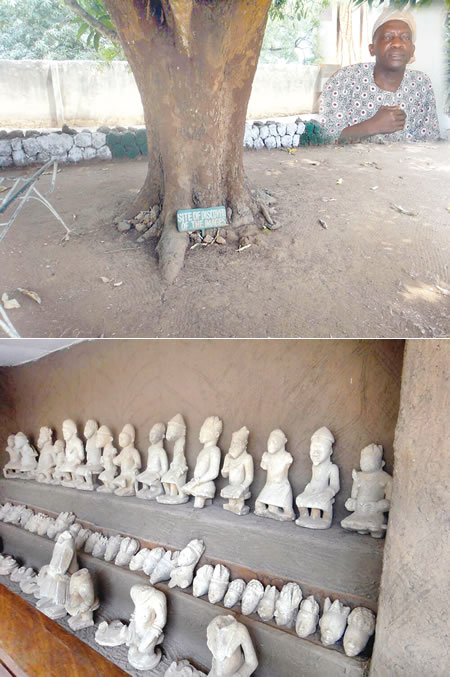THE location of the museum in Esie, Irepodun Local Government Area of Kwara State is both strategic and symbolic. It is a National museum, housing the largest stone images in sub-Saharan Africa, located around the vicinity where these soap stone images were originally found by members of the Esie community centuries back, specifically around 1775.
Initially, nobody knew how the stones got there. So when members of the community saw them for the first time, it was a discovery enrobed in mystery and so members of the community turned the area where the stone images were discovered into a shrine and began to worship them.
Esie museum, the first of its kind in Nigeria, established in 1945 has received local and foreign tourists in recent years, particularly when the notion of the place being a shrine began to gradually fade away.
The museum which now has both old and modern galleries housed more than 2,000 images and objects. The old gallery has a collection of soapstone images with artistic depiction of human beings.
Speaking with the Curator of the museum, Mrs. Elizabeth Mopelola Omowumi, she told Sunday Tribune that the old gallery houses between 1,000 and 1,500 stone images while the modern gallery has over 500 of the images.
The stone images according to history were discovered by one of the town’s residents said to be refugees from old Oyo who had migrated to the point where the museum is currently standing. The man, a famous hunter known as Baragbon, made the discovery during his hunting expedition and went back to tell his people.
“When Baragbon discovered this place, he went back to inform his people and they consulted Ifa (oracle) to ascertain whether they used to be human beings. Ifa confirmed that they used to be human beings who turned to stones because of their evil intentions and disobedience to the supreme being who cursed and petrified them, making all of them to remain in the various postures they had assumed at the time of the curse.”
Since then the Esie people began to worship the images until 1933 when it was brought to limelight by one of the European missionaries, an education inspector who was sent to the area. The colonial officer went back to inform the then colonial governor who became interested in the figurines and subsequently the museum was established in 1945,” she said.
But the archaeologists who examined the stones came up with a different view after the discovery and establishment of the museum. The archaeological position debunked the earlier belief. According to the Senior Assitant Museum Education Officer, Mr Robert Omotoya, the stones were never human beings but images carved by unknown persons, whose reasons for embarking on such a creative enterprise had remained unknown.
“The images are man-made, carved by the people. But no one has been able to identify the supposed carvers to support the claim that the images are carved objects. And, the Esie community has no historical antecedence as stone carvers,” he explained.
It was reported that colonial visitors to Esie, including Leo Fronebius, the German traveller and anthropologist who visited the site in 1912, were amazed to discover a collection of stone carvings of men and women, musical instruments, household utensils, guns and cutlasses all carved out of soap stone, and that the artistic genius the carvers demonstrated, excited their curiosity about the antecedents of the images and encouraged them to create a museum to preserve them for posterity.
The museum that was established by the colonial masters at the site as a tourist attraction in 1945 became the forerunner of other museums in the country being managed by the National Commission for Museum and Monuments (NCMM).
Omotoya confirmed that the stone images were formerly in the custody of the community, which was worshipping them until government took over their preservation.
After the takeover, the community was still allowed to worship the stones but this spiritual attachment was later severed by the present traditional ruler of the community, Oba Y. A Babatola Egungunjobi, a devoted Muslim who believes that human beings now have a direct contact with God, instead of reaching Him through an intermediary.
“When the idea of worshipping the stone images was cancelled, the elite of the community came up with an idea of keeping up the tradition. They then modernised it and named it a monument festival that is now celebrated annually, during which there would be series of programmes such as paper presentation, hunting expedition and the like. The festival is usually celebrated in April but it has been stopped in the last few years due to reason best known to the people,» the Chief Education Officer and one of the oldest members of staff of the museum, Mr. Ajayi Johnson Ademola, narrated. He however added that the situation in the museum has improved.
Some of the objects in the museum, finding shows were purchased while some were donated and others were obtained as loan from other museums in the country.
Some of the Esie artefacts that were stolen and found in France were returned a few years back to Nigeria, however, the objects are still at the museum headquarters in Abuja.
A source of revenue
The case is the same with Esie museum, but this has greatly changed as a result of sensitisation embarked on by the staff of the museum.
“We have also succeeded in attracting people to visit this place for relaxation and education of our younger generation. We have been carrying out sensitisation programme to market the museum for people to come and see. The sensitisation programme has also changed people’s thinking about the museum. Initially, many people believed that what we have here are objects of antiquity that we worship but we were able to convince people with our road show and radio programmes that the museum is not a shrine or a place of fetish but a place of education, relaxation and research.
“Since then, the visit to this place have increased. We usually have like 100 people monthly before but now we have more than a thousand people visiting here on monthly basis and more than 2000 during festivals.
“We equally wrote letters to secondary schools and higher institutions to let the younger generations know about our culture which is almost going into extinction such as moral value, respect for elders, obedience etc.
“We have also reached out to law enforcement agencies like Customs and Immigration to sensitise them on how to identify the contemporary objects and objects of antiquity at our border posts. Whatever they intercepted at the border, they have to inform the museum because museum is only the accredited agent that can issue export permit and once such object is discovered, the museum have to identify it.
“During Children’s Day celebrations, we normally package programmes for secondary school students on cultural heritage. We sensitise them to the importance of our culture and let them also know that the museum is not a place of worship and let them also know the stages we have passed in terms of development. With all the efforts put forward so far, we make about N10,000 monthly but this is not regular,” the chief education officer said, adding that the improved patronage has also led to the expansion of manpower at the museum.
“When I resumed work, in terms of manpower we were about 20, but today we have over 40 members of staff. In terms of infrastructure, we had only mud houses before; one gallery, one store and general office. But thank God, government answered our calls with the construction of a modern gallery to showcase unity in diversity. In 2012, a modern gallery was built for that purpose and whoever comes to the museum from any part of the country would see artefacts representing their people and cultural heritage. The modern gallery showcases cultural materials from every part of the country unlike before when we had only stone images.
“In terms of security, the men of the Nigeria Police are complementing the effort of our security people because a police officer is usually posted here at night to support our security system and the place has also be secured with the building of fence around the gallery which comprises of the internal and external fences to secure objects in the museum,” Ademola explained.
Whatever the controversies over the Esie figurines may continue to be even in the future, one thing is clear, their presence in the museum has impacted on the community positively. Apart from putting Esie on world cultural map, it has also generated employment for some indigenes of the town. The tourists who throng the town on a regular basis to pay homage to the mysterious figurines have also boosted the economy of the in no small measure.





